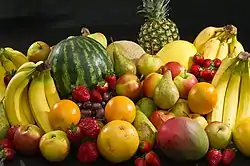果物
Japanese
Etymology 1

果物 (kudamono, kabutsu): various kinds of fruit.
| Kanji in this term | |
|---|---|
| 果 | 物 |
| Grade: 4 | もの Grade: 3 |
| irregular | kun’yomi |
Literally “tree's thing”. Originally a compound of 木 (ku, “tree”, shift from ancient ko pronunciation) + だ (da, possessive marker between two nouns, only found in a few compounds) + 物 (mono, “thing”).[1][2]
The medial da is also seen in 獣 (kedamono, “beast”, literally “hairy thing”). The kanji is jukujikun (熟字訓).
Noun
果物 • (kudamono)
Synonyms
- フルーツ (furūtsu)
Derived terms
See also
Etymology 2
| Kanji in this term | |
|---|---|
| 果 | 物 |
| か Grade: 4 |
ぶつ Grade: 3 |
| kan’on | |
/kwabut͡su/ → /kabut͡su/
Possibly from Middle Chinese compound 果物 (*guɑ *miət, literally “fruit thing”). Compare modern Mandarin 果物 reading guǒwù (rare), Cantonese gwo2 mat6 (rare).
Rarely used in modern Japanese.
Pronunciation
- IPA(key): [ka̠bɯ̟ᵝt͡sɨᵝ]
Usage notes
The kudamono reading is much more common in modern Japanese.
References
- Shōgaku Tosho (1988) 国語大辞典(新装版) [Unabridged Dictionary of Japanese (Revised Edition)] (in Japanese), Tōkyō: Shogakukan, →ISBN
- Matsumura, Akira, editor (2006), 大辞林 [Daijirin] (in Japanese), Third edition, Tōkyō: Sanseidō, →ISBN
This article is issued from Wiktionary. The text is licensed under Creative Commons - Attribution - Sharealike. Additional terms may apply for the media files.